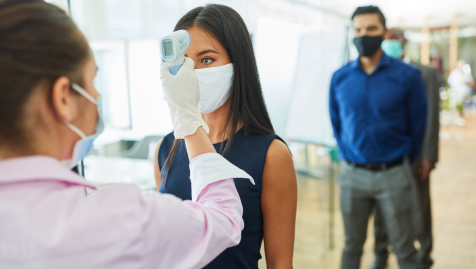
This policy helps companies to deal with the unforseen situations in the pandemic and lay down a policy in order to protect the interests of company and clients, and ensure wellbeing of all employees in terms of safety, comfort and assistance in times of need. This policy is a necessity in the present scenario.
This policy template is available for download in Word format.
With this Comprehensive Document on Covid Policy, You Can:
- Create a well-defined process to face up to, survive, sustain and bounce back from such adversities
- Identify what needs to done by all concerned
- Create an easily understandable Do’s and Don’ts
- Provide a more solution-oriented guideline
In just a few minutes, you will be able to create a comprehensive document on covid policy. This policy covers vital information like:
- Step-by-step guideline to each function, such as administrators and employees alike
- Protection and prevention guidelines for visitors and clients
- Understanding of how disruptive thinking can actually lead to simple sustainable survival options
Comprehensive Document on Covid Policy
Objective
The objective of this policy is to provide guidelines to HR and employees about the safety precautions and work management in < Company name > in the COVID or any other pandemic period.
Scope and Applicability
This Policy applies to all employees at all levels in < Company Name >.
This policy is owned by < Name of the Person > and reachable @ < Contact Number > and < email address >
Policy / Process
Introduction
It is likely that Coronavirus Disease 2019 (COVID-19) will continue to occur in the community in the foreseeable future. It is therefore important to have a plan in place in order to reduce the impact of COVID-19 on businesses, employees and customers. This guidance is intended for the purpose of helping businesses to plan for preventing the spread of COVID-19 at the workplace and for precautions to be taken for those impacted by the disease. Businesses and employers should also obtain up-to-date and authentic information from websites of Ministry of Health and Family Welfare (MOHFW), State Government (especially for identifying containment zones), PHDCCI, ASSOCHAM, FICCI, CII, NASSCOM, etc. It is important to collaborate with employees and unions to not only effectively communicate important COVID-19 information but also to assess risk in order to find solutions.
With the help of these general guidelines, they should prepare , implement and update, as necessary, a customised plan which:
- is specific to the business and its workplaces and processes.
- identifies all areas and tasks with potential exposure to COVID-19.
- includes control measures to eliminate or reduce such exposure that prevents and reduces transmission among workers.
- helps in maintaining a safe business operation and a healthy work environment.
About Covid-19
- Patients with COVID-19 typically have fever, cough, sore throat and body ache with or without difficulty in breathing. Some people may lose their senses of smell and taste or may have diarrhoea.
- Risk of serious illness rises with age. People of any age with conditions such as high blood pressure, cancer, diabetes, heart, kidney or lung disease, etc., are also at a high risk of serious illness.
- Covid-19 spreads very easily. When an infected person coughs, sneezes, laughs, talks or touches another person, small droplets containing the virus that causes COVID-19 get transported to the other person or persons close by and infect them too. People within 2 meters are most at risk. The droplets also fall on nearby surfaces and objects, and people could then get infected by touching such contaminated surfaces or objects.
- The virus spreads most easily where people are confined in a small space or in an area without adequate ventilation.
- People who are infected but do not show any symptoms can also spread the disease.
General Principle
Every person (with or without symptoms) in the workplace should be considered as a potential source of infection and every precaution has to be taken. All the risk factors, including those associated with various worksites and the tasks workers perform at those sites, must be taken into account. They include:
- Sources of infection at workplace, such as:
- The general public, customers, suppliers, workers, etc.
- Sick individuals or those at particularly high risk of infection, e.g., healthcare workers and travellers who have visited locations with widespread COVID-19 cases.
- Tasks performed by the employee.
- Non-occupational risk factors at home and in the community.
- Workers' individual risk factors for serious disease as mentioned above.
- Worker's mental well-being
Basic Infection Control Measures
- As the disease spreads mainly when a patient coughs, sneezes, talks or laughs, it is important for everyone to cover their mouth and nose with a mask in public. The mask has to be consistently worn and should be worn and taken off correctly.
- For the same reason, respiratory etiquette should be practised. It includes covering coughs and sneezes with the arm or elbow or with tissue that should be disposed of in a closed bin.
- Frequent and thorough hand washing with soap and water for at least 40 seconds or with a sanitiser containing at least 60% ethyl alcohol or 70% isopropyl alcohol decreases the risk of getting the disease from contaminated surfaces. Hand washing with soap and water for at least 40 seconds is much better than using sanitisers.
- Social distancing of at least 2 meters between people is a potential game changer in limiting the spread of COVID-19. A distance of 2 meters between people minimises the risk of spread of COVID-19. WHO recommends at least 10 square meters of space around each worker.
- The virus may also be present on frequently used surfaces that have been contaminated by a person with COVID-19. A worker may touch an infected surface and get infected. 1% freshly prepared sodium hypochlorite solution or a solution of more than 60% ethyl alcohol kills the virus.
Workplace Controls
Preventive Measures for Workplace Environment
There are advantages and disadvantages to each type of control measures when considering the ease of implementation, effectiveness and cost. A combination of these measures will be necessary to protect workers. These are generic guidelines and they should be adapted to suit the nature of the business, its workplaces, its processes, its employees and the tasks they perform.
Engineering Controls
Physical Modifications and barriers
- Structural modifications in the workplace to maintain social distancing norm and ventilation.
- Installation of physical barriers such as clear glass/Plexiglas/ acrylic or any other suitable partition, wherever possible, between workstations, at the reception, between other work areas and where there is public interaction.
- Avoid stuffy / congested / small meeting rooms where more than 2 persons need to meet.
Workspace Air: More Outdoor Air Ventilation
- Increasing outdoor air ventilation in air conditioners at the workplace/shop floor by opening doors and windows or installing exhausts.
- Switching on exhausts/ventilation systems 2 hours prior to and 2 hours after the building usage time.
- Keeping toilet exhaust fans open 24/7.
- Avoiding the use of central air conditioning. Using individual room air conditioners with HEPA filters when absolutely necessary.
- Ensuring that ventilation systems operate properly and provide acceptable indoor air quality for the occupancy level for each space.
Administrative Controls
Administrative changes are relatively easier to implement and go a long way towards minimising the risk of spread of COVID-19. Set up teams or identify individuals, if possible, for managing various tasks related to infection control:
- Discourage visitors. Allow visitors with prior appointments only. Whenever possible, their Aarogya Setu status should be checked before entry. No visitor should be allowed beyond the reception area.
- Do not use biometric attendance systems. Discontinue frisking.
- Use calibrated infrared, no-touch thermometers at the entrances of the facility to measure temperature of all visitors and all workers. Enquire about symptoms of COVID-19.
- All those with fever or symptoms should be asked to go back home and seek immediate medical attention. Maintain an entry and exit register. Allow entries and screenings at multiple places to avoid crowding.
- Encourage workers with symptoms of COVID-19 to inform their supervisor and stay at home and seek medical attention. Promote the message that workers should stay home even if they have mild symptoms. Allow workers to stay at home to look after family members with COVID-19 and to self-monitor.
- Make sure that all workers and visitors sanitise their hands with an alcohol-based sanitiser before entering office premises each time.
- Avoid physical touch with visitors like handshakes, embracing,etc.
Respiratory Hygiene: Mask Compulsory
- Insist that workers and visitors wear a mask before entering and during their stay in the facility. Make it non-negotiable. Procure masks for workers or encourage them to sew three layered cloth masks that can be reused after washing with soap and water.
- Teach workers the correct technique of wearing and taking off a mask with the help of actual demonstration and with the help of posters and audio-visual aids.
- Encourage respiratory etiquette and demonstrate how to do it properly to workers. Provide tissues and covered waste bins at convenient locations.
Workspace Hygiene: Frequent workspace sanitisation & hand washing, no sharing and no touching
- Maintain regular housekeeping practices, including cleaning and disinfecting of all floors, light switches, entrance gates, kitchen, washroom floors, counters, taps, sinks and toilet seats, machinery, doors and windows handles and knobs, staircase rails, work stations, tables and desks, chairs, vehicles (especially contact points) and objects like telephones and computer keyboards, etc., and other elements of the work environment at least twice daily, once before each shift. High-touch surfaces should be identified for priority disinfection. Make sure that there is a gap of one hour between shifts to enable proper sanitisation. 1% freshly prepared Sodium Hypochlorite solution may be used for the purpose. Alcohol-based sanitiser can be used for those surfaces that can't be cleaned with Sodium Hypochlorite. Provide materials to workers to clean their workplaces. Store and use disinfectants in a responsible and appropriate manner according to the label. Ensure good quality, Government-approved materials.
- Clean garbage bins and areas around them daily, at the end of the day, with soap solution and disinfect with 1% freshly made Sodium Hypochlorite solution. Ensure that all persons handling garbage wear gloves, masks, gowns and boots.
- Insist on frequent cleaning of hands by workers and other visitors with soap and water or with a sanitiser. Ensure that hand sanitisers are placed at the entrance, near all touch points, in washrooms and in multiple easily accessible place and that they are regularly refilled. All employees must clean their hands before and after work shifts, before and after work breaks, after blowing their nose, coughing, or sneezing, after using the restroom, before eating or preparing food and after putting on, touching, or removing masks. Place posters that encourage hand hygiene.
- Discourage people from touching common surfaces like gates, staircase banisters, walls, door handles with their hands and encourage them to use their elbows, shoulders or arms to open doors. Innovative messaging in the form of red paint and suitably placed signs should be placed for the purpose. Remove door handles and knobs wherever possible or replace it with automated doors. Dedicated personnel can also be deputed to open doors and operate lift, using gloves.
- Remove newspapers, magazines and other paper material that might come in contact amongst individuals.
- Disallow workers from sharing pens, phones, desks, offices, computers or other work tools and equipment.
- Create a place and a mechanism by which parcels and mail can be delivered to a single place without contact. Make deliveries contactless.
- Use packaged water and disposable cups for beverages.
- Educate employees to make a habit of not touching their nose, mouth or eyes.
- Spraying or fogging is generally not recommended. Spraying people with disinfectants (such as in a tunnel, cabinet or chamber) is harmful and not recommended under any circumstances.
Workplace Social Distancing: Physical and functional changes, remote working and remote services
- Ensure a distance of 2 meters between tables and desks and between various work areas and other spaces in the facility by modifying the work space, if need be. Mark areas around individual workspaces with visual indicators like barricade tape, floor tape, cones, etc., in order to limit encroachment by others.
- Reduce density of people in the building and ensure physical spacing in common spaces such as entrances/exits, lifts, pantries/cafeterias, stairs and lobbies, etc.
- Make sure that everyone understands that they must ensure a distance of at least 2 meters from each other at all times. Use signs, colour marks or other visual cues such as coloured tape on the floor placed 2 meters apart to indicate where to stand when physical barriers are not possible. Use verbal announcements, signage and visual cues to promote social distancing.
- Limit access to common areas like cafeterias, changing and locker rooms, washrooms, etc.
- Suspend recreational activities, prohibit unnecessary movement by workers.
- Deliver services remotely (e.g. by phone, video or web) where possible. Use contactless/cashless payment systems. Move the electronic payment terminal/credit card reader farther away from the cashier.
- Replace face-to-face meetings with virtual meetings. Cancel all non-essential meetings. Avoid huddles and other gatherings; address workers, if needed, by PA system. In case a meeting is unavoidable, minimise the number of people. Advise participants not to attend if they feel unwell. If possible, hold meetings in open spaces.
- Flexible worksites, e.g. work from home, tele-working and flexible work hours like staggered shifts, split teams, alternate-day working or extra shifts, help to reduce the number of employees reporting at the same time. This will not only increase the physical distance among employees but between employees and others.
- For jobs requiring collaboration that would interfere with social distancing, redesign the production flow.
- Make small teams of workers and keep the membership of the team fixed. Minimise contact between workers of different teams.
- Make all documentation and processes like communications, bills, invoices, job cards, filings, trainings, etc., online/paperless
- Stairs should be preferred over lifts. The number of people should be restricted in lifts. Users should face the walls on clearly marked-out places at least three feet away from each other. Sanitise all lifts twice daily.
- Reception and dispatch of supplies and material should be staggered and done during off hours. Limit the number of workers involved and make safety protocols for loading and unloading so as to maintain social distancing. All involved persons should wear masks and wash hands before and after loading/unloading. Discourage outside workers from entering your facility. If possible, disinfect materials before using them. Sanitise trucks before loading and after unloading.
Travel Advisory: Only unavoidable travel, basic infection control measures while traveling
- Discontinue nonessential travel.
- Do not allow employees who are at high risk of serious illness to travel.
- Provide the employee with a small bottle of hand sanitiser when he/she goes out.
- Make sure he/she will wear a mask and take all basic infection control measures mentioned above and avoid loitering, avoid touching surfaces as much as possible and avoid crowded places.
- Ensure that employees who become sick while travelling or on temporary assignment understand that they should notify their supervisor and promptly call a healthcare provider for advice if needed.
Cafeteria: Social distancing and hygiene measures
- Ideally, cafeterias should be discontinued and packed lunches should be made available or employees should be encouraged to carry their own food and eat at their desks.
- If it's not possible, discontinue self-service.
- Use disposable cutlery and crockery, if possible. If utensils are reused, ask workers to wash their utensils.
- Stagger meal times and ensure physical distancing between workers and tables.
- Prohibit eating in groups and sharing of food and utensils.
- Cafeteria food handlers should frequently sanitise their hands and must wear masks.
- Keep the dining area clean and sanitise it at least twice daily.
Workers Transportation
- Arrange transportation of employees from home to work, if possible.
- Drivers should wear masks and should be checked for symptoms.
- Social distancing norms must be followed in the vehicle.
- Encourage workers to avoid public transport and walk or cycle to work.
- Educate workers to wear a mask when using public transport and sanitise their hands before boarding and after alighting.
- Discourage car pools and chauffeurs. Discourage workers from going out during breaks.
Human Resource: Worker safety and education
- Make changes in the HR policies to reflect the core concern for safety for all. Provide health cover for all, be it ESIC cover or private Mediclaim policy.
- Tie up with a nearby Medical Practitioner or hospital.
- Develop a special leave policy, with respect to Covid-19.
- Provide workers with up-to-date education and training on COVID-19 symptoms, risk factors and protective behaviours. Training material should be easy to understand and available in vernacular language. Posters, talks, presentations and audio-visuals aids can be used to spread Covid-19 literacy. Reinforce them regularly with repeated announcements over P.A. systems by holding regular drills and interactive training sessions. Display Government Helpline numbers and address and contact numbers of nearest government/private clinics and hospitals.
- COVID-19 is associated with a range of concerns, such as fear of falling ill and dying, of being socially excluded, of losing a livelihood, domestic issues or bereavement. There is also the overwhelming, potentially depressing information overload from the audio-visual and social media. Anxiety and depression are therefore common. Psycho-social support should be made available to all workers. Set a culture of open, communicative and compassionate leadership and facilitate medical attention where needed. Urge workers to limit media consumption.
- Make the use of Aarogya Setu application mandatory.
- Make communication between workers, supervisors and managers easier with the help of telephones or internet applications which can also be used to report sickness or to notify employees of exposures and closure.
Use and wear of PPE kits
PPE kits should be:
- selected based upon the hazard to the worker.
- consistently worn.
- regularly inspected, maintained and replaced, as necessary.
- properly worn, removed, sanitised and stored/disposed of as per protocol in order to avoid the spread of disease.
Management of Sickness at the Workplace
The employer/supervisor/co-workers must promptly identify and isolate workers with symptoms of COVID-19 at the workplace. In case he/she is not wearing a mask, the same should be provided immediately. An isolation facility like a small, well-ventilated room with a closable door can be created to isolate such a worker till he/she is sent for medical attention. Otherwise the worker should be moved immediately to an open area away from others. In most cases, there is no need to shut down the facility. Close off any areas used for prolonged periods of time by the sick person after opening its windows and doors. Wait 24 hours before cleaning and disinfecting.
- Clean dirty surfaces with soap and water before disinfecting them.
- Use freshly made 1% Sodium Hypochlorite or 60% Ethyl alcohol solution, whichever is appropriate for surfaces and objects.
- Mask, gloves, goggles/face shield, gown and boots must be worn by the person who is cleaning and disinfecting.
- Determine which other employees may have been exposed and may need to take additional precautions.
- Inform employees of their possible exposure to COVID-19 in the workplace but maintain confidentiality.
- Instruct all employees not wearing a face mask and in prolonged/repeated close contact (i.e. within 2 meters) with such a person to quarantine at home for 14 days, tele-work if possible, self-monitor for symptoms and report sickness and follow the MOHFW/State government guidelines.
- Other employees can continue working and are asked to closely monitor and report any symptoms.
- Employers also have an obligation to manage potentially exposed workers' return to work in ways that best protect the health of those workers, their co-workers and the general public.
Special Circumstance and Exception
Any deviation from this policy has to be approved by Management. Any changes to the policy has to be approved by Legal and Compliance.
Non-compliance and Consequence
Violation of this Comprehensive Document on Covid Policy is subject to disciplinary action, up to and including termination. If an employee, including Floor Supervisor and/or Manager, is suspected of violating the policy, he/she must undergo a thorough investigation. The circumstances of each violation will determine the severity of each scenario.








